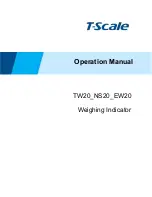
MI 2893 / MI 2892 / MI 2885
Measurement methods
198
Voltage interrupt
Standard compliance: IEC 61000-4-30 Class A (Section 5.5)
Measuring method for voltage interruptions detection is same as for dips and swells, and is described in
previous sections.
The Interrupt Threshold is a percentage of nominal voltage defined in CONNECTION menu. Interrupt
Hysteresis is difference in magnitude between the Interrupt start and Interrupt end thresholds. The
interrupt threshold can be set by the user according to the use. Instrument event evaluation in Event
table screen depends on Connection type:
On single-phase system (1W), a voltage interruption begins when the U
Rms(1/2)
voltage falls below
the voltage interruption threshold and ends when the U
Rms(1/2)
value is equal to, or greater than,
the voltage interruption threshold plus the hysteresis
On poly-phase systems (2W, 3W, 4W, Open Delta) two different view can be used for evaluation
simultaneously:
o
Group view
with selected
ALL
INT
view: a voltage interruption begins when the
U
Rms(1/2)
voltages of all channels fall below the voltage interruption threshold and
ends when the U
Rms(1/2)
voltage on any one channel is equal to, or greater than, the
voltage interruption threshold plus the hysteresis.
o
Phase view Ph.: a voltage interrupt begins when the U
Rms(1/2)
voltage of one channel
fall below the interrupt threshold, and ends when the U
Rms(1/2)
voltage is equal to or
above the interrupt threshold plus the hysteresis voltage, on the same phase.
Figure 162:Voltage interrupts related screens on the instrument
A voltage interrupt is characterized by following data: Interrupt Start time, Level (U
Int
)
and Interrupt
Duration:
U
Int
– minimum interrupt magnitude voltage, is the lower U
Rms(1/2)
value measured on any
channel during the interrupt. It is shown in Level column in the Event Table on the instrument.
The Interrupt Start time of a interrupt is time stamped with the time of the start of the U
Rms(1/2)
of the channel that initiated the event. It is shown in START column in the Event Table on the
instrument. The Interrupt End time of the interrupt is time stamped with the time of the end of
the U
Rms(1/2)
that ended the event, as defined by the threshold.
The Interrupt Duration is the time difference between the beginning and the end of the
interrupt. It is shown in Duration column in the Event Table on the instrument.
5.1.14
Alarms
Generally, alarm can be seen as an event on arbitrary quantity. Alarms are defined in alarm table (see
section 3.23.3 for alarm table setup). The basic measurement time interval for: voltage, current, active,
nonactive and apparent power, harmonics and unbalance alarms is a 10/12-cycle time interval.
















































